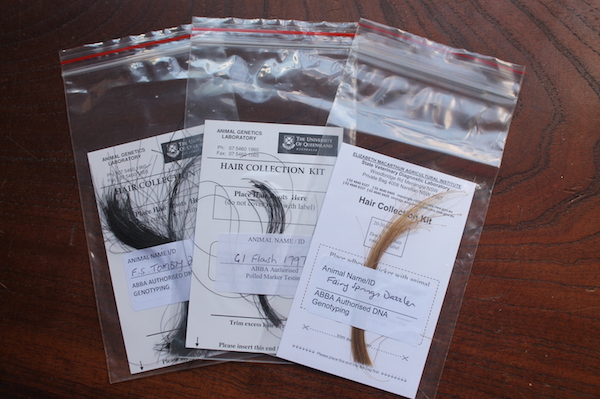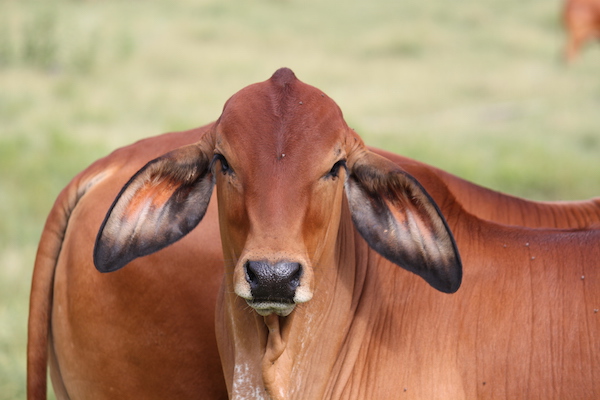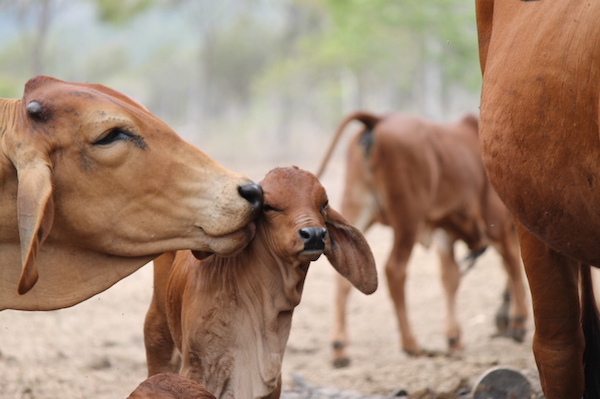The sky is the limit
Host: White Kangaroo Station
Written by Sarah Streeter – Manager, White Kangaroo Station.
It may come to a surprise to some that we are using quite advanced genetic diagnostic and profiling technology in our stud cattle herd. Genetic technologies have a number of applications to our herd, most which can be easily related to commonly-used diagnostics in our own two-legged society.
Genetic material is collected from a cow, bull, or calf in a very simple and painless process of pulling a tail hair sample.
We use one of the earliest genetic tests developed and that is the parentage test (paternity test). A stud (registered) animal has a fully recorded pedigree, just like we see with pedigree horses and dogs. We run a comparatively large stud herd (around 400 cows), with up to 150 cows in one paddock. We mate at a ratio of 1 bull to about every 30 cows, so we must have more than one bull with the large groups of cows during the breeding season. Hence the requirement for a DNA paternity test. We obtain a tail sample from all calves at the time of branding and I have a file in my office that contains a sample of all sires/bulls that have been used in our herd over the past five years. These samples are sent away to the University Of Queensland Animal Genetics Laboratory for profiling and matching of a sire to each calf. These calves can then be recorded with Australian Brahman Breeders Association as a fully registered stud animal. Smaller herds, where only one bull is mated to a small group of cows do not require this form of testing to appoint a sire to a calf. The cost of a paternity test in cattle is around $25 per animal, which is a cost we must absorb when we are running a stud herd under the extensive conditions of northern Australia.
 Tail hair samples of sires ready to send to the laboratory.
Tail hair samples of sires ready to send to the laboratory.
 Reid helps out with “mothering up” in the stud herd, where we record the identification number of a calf’s mother for its pedigree.
Reid helps out with “mothering up” in the stud herd, where we record the identification number of a calf’s mother for its pedigree.
For many years now we have had genetic diagnostic tests to determine whether an animal is carrying a gene that will lead to an inherited genetic disorder. An animal may be carrying a recessive or “silent” gene that we can’t “see” by looking at the animal, but if it is mated to another animal that is also carries this same gene, the resulting calf may display the disorder. Pompes disease is one such inherited genetic disorder which we test for in Brahman cattle. An animal can carry one copy of the gene and be completely normal, but a calf with two copies of the gene will have Pompes disease and will waste away. Affected calves generally will not survive beyond 12 months of age. Genetic diagnostic tests allow us to avoid breeding animals that may pass on a genetic disorder.
Things get more exciting from there . . . (well, for a cattle breeding enthusiast it does!)
In more recent years, scientists have developed tests for traits which are under more complex genetic control. These are traits that may be determined by a large number of genes (rather than a single gene), where there are interactions between genes, or other complex factors at play. We have been using a gene marker test for meat tenderness in our stud herd for approximately 10 years now, whereby we can determine animals that will produce meat that has a lower shear force (a measurement of tenderness). This is an incredible opportunity for improving meat quality through breeding, as the trait is heritable. By taking a DNA sample (tail hair) and submit for testing, we can select breeding animals that are likely to produce progeny with meat that is more tender. Before this, we only know whether an animal produces good quality meat once that meat it is on our plate – not very helpful for breeding!
For us, perhaps one of the most exciting genetic tests released recently is the poll gene marker test. A poll animal is one which is genetically free from horns i.e. does not require dehorning. We have been selecting visually for “pollness” in our stud herd for almost 20 years now, as my father had long valued the trait for there being less stress on the animal at branding. It is a complex trait in Brahman cattle as well as in some other breeds, whereby an animal may appear polled but can be carrying a “silent” horn gene. We donated polled cows and their calves to CSIRO for the research in understanding the genes controlling this trait and we were thrilled to see a commercial gene test released a few years ago. We can now determine through genetic testing whether an animal is a homozygous poll (carries two copies of the poll gene) or a heterozygous poll (carries one poll gene and one horn gene). Almost all calves bred by a homozygous poll bull, regardless of the horn status of the cow, will be polled. This provides the opportunity for a much more rapid increase in the prevalence of polled animals in our industry thereby reducing the number of animals that require dehorning.
 A polled animal. These animal exhibits the prominent “poll” or bony protrusion at the centre top of her head in the absence of horns.
A polled animal. These animal exhibits the prominent “poll” or bony protrusion at the centre top of her head in the absence of horns.
I have no doubt that we are only in the infancy stages of genetic technologies with applications to improving productivity and welfare outcomes for our industry. The sky is the limit and we certainly have a big sky in northern Australia.
 We can now learn so much about the animal from the day it is born just by taking a hair sample and submitting it for DNA profiling.
We can now learn so much about the animal from the day it is born just by taking a hair sample and submitting it for DNA profiling.
